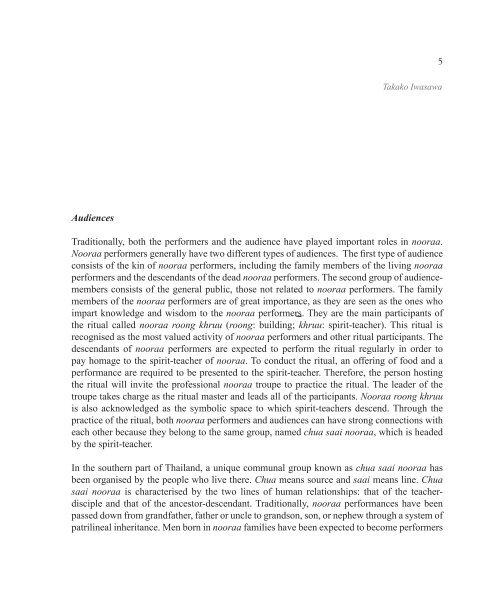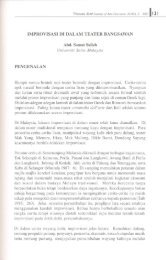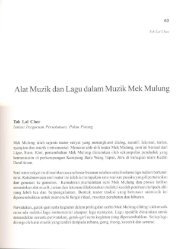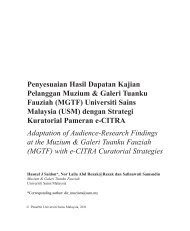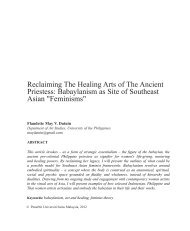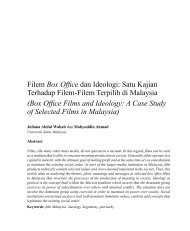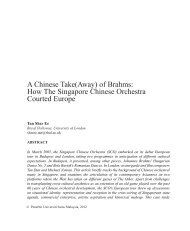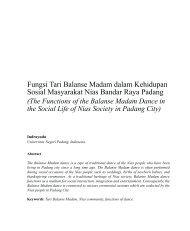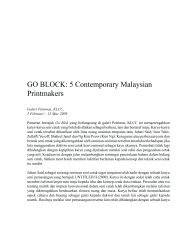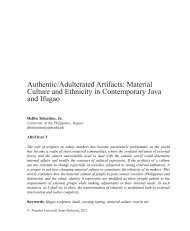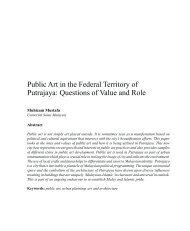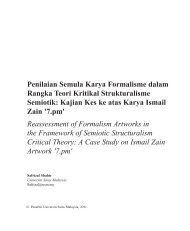Preservation of Traditional Art: The Case of the ... - Wacana Seni
Preservation of Traditional Art: The Case of the ... - Wacana Seni
Preservation of Traditional Art: The Case of the ... - Wacana Seni
You also want an ePaper? Increase the reach of your titles
YUMPU automatically turns print PDFs into web optimized ePapers that Google loves.
5Takako IwasawaAudiences<strong>Traditional</strong>ly, both <strong>the</strong> performers and <strong>the</strong> audience have played important roles in nooraa.Nooraa performers generally have two different types <strong>of</strong> audiences. <strong>The</strong> first type <strong>of</strong> audienceconsists <strong>of</strong> <strong>the</strong> kin <strong>of</strong> nooraa performers, including <strong>the</strong> family members <strong>of</strong> <strong>the</strong> living nooraaperformers and <strong>the</strong> descendants <strong>of</strong> <strong>the</strong> dead nooraa performers. <strong>The</strong> second group <strong>of</strong> audiencemembersconsists <strong>of</strong> <strong>the</strong> general public, those not related to nooraa performers. <strong>The</strong> familymembers <strong>of</strong> <strong>the</strong> nooraa performers are <strong>of</strong> great importance, as <strong>the</strong>y are seen as <strong>the</strong> ones whoimpart knowledge and wisdom to <strong>the</strong> nooraa performers. <strong>The</strong>y are <strong>the</strong> main participants <strong>of</strong><strong>the</strong> ritual called nooraa roong khruu (roong: building; khruu: spirit-teacher). This ritual isrecognised as <strong>the</strong> most valued activity <strong>of</strong> nooraa performers and o<strong>the</strong>r ritual participants. <strong>The</strong>descendants <strong>of</strong> nooraa performers are expected to perform <strong>the</strong> ritual regularly in order topay homage to <strong>the</strong> spirit-teacher <strong>of</strong> nooraa. To conduct <strong>the</strong> ritual, an <strong>of</strong>fering <strong>of</strong> food and aperformance are required to be presented to <strong>the</strong> spirit-teacher. <strong>The</strong>refore, <strong>the</strong> person hosting<strong>the</strong> ritual will invite <strong>the</strong> pr<strong>of</strong>essional nooraa troupe to practice <strong>the</strong> ritual. <strong>The</strong> leader <strong>of</strong> <strong>the</strong>troupe takes charge as <strong>the</strong> ritual master and leads all <strong>of</strong> <strong>the</strong> participants. Nooraa roong khruuis also acknowledged as <strong>the</strong> symbolic space to which spirit-teachers descend. Through <strong>the</strong>practice <strong>of</strong> <strong>the</strong> ritual, both nooraa performers and audiences can have strong connections wi<strong>the</strong>ach o<strong>the</strong>r because <strong>the</strong>y belong to <strong>the</strong> same group, named chua saai nooraa, which is headedby <strong>the</strong> spirit-teacher.In <strong>the</strong> sou<strong>the</strong>rn part <strong>of</strong> Thailand, a unique communal group known as chua saai nooraa hasbeen organised by <strong>the</strong> people who live <strong>the</strong>re. Chua means source and saai means line. Chuasaai nooraa is characterised by <strong>the</strong> two lines <strong>of</strong> human relationships: that <strong>of</strong> <strong>the</strong> teacherdiscipleand that <strong>of</strong> <strong>the</strong> ancestor-descendant. <strong>Traditional</strong>ly, nooraa performances have beenpassed down from grandfa<strong>the</strong>r, fa<strong>the</strong>r or uncle to grandson, son, or nephew through a system <strong>of</strong>patrilineal inheritance. Men born in nooraa families have been expected to become performers


